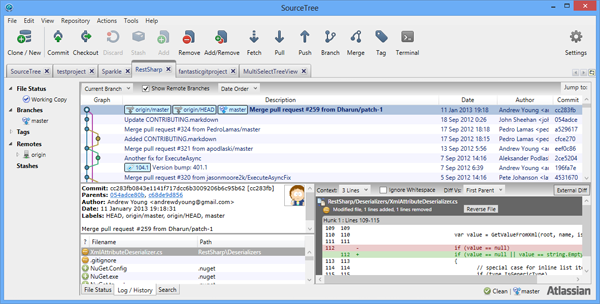

- #Simple git server how to#
- #Simple git server install#
- #Simple git server full#
- #Simple git server software#
- #Simple git server code#
#Simple git server code#
If you’re looking at getting into programming, then it is important that you learn about code version control systems. I have come across a couple of websites that have been incredibly helpful in learning more about Git and how it works. Now there is a lot more to learn about Git and the commands you’re able to use. Now, this is the very basics of Git, and there is so much more to learn. First, open up Git bash in a different folder and then run the following commands: git clone As you can see, the Raspberry Pi Git server is now storing our code correctly. To test to see if everything is working correctly, you can clone the repository we just set up to a new folder. This message means our code has been pushed to our Git server.ġ2. It should come up with a success message. git remote add myFirstRepository Now we can easily push data to our repository. Now we need to add our remote Git directory by adding the following line. To do this enter the following command: git initĩ. If this is not already a Git directory, then you will need to initialize it before we can push the code to our Pi. It should open a window that looks like a command prompt.Ĩ. In the folder you wish to commit, right click and then go to Git bash. Once you have installed it, you should have some extra options when you right click within a folder.ħ. I recommend downloading and using git-scm.Ħ. On Windows or Mac computer you will need to download Git to be able to start pushing code to our repository. Now that’s all done we’re ready to do our first commit.ĥ. You will need to repeat these steps whenever you need to make a new repository. Now let’s initialize the Git repository using the bare command. Now let’s move into the directory by using the cd command. mkdir -p /home/pi/git/myFirstRepositoryĢ. The -p tag will create any directories in our path that doesn’t already exist. Firstly, we need to make a directory for where our new repository will be stored. There are more complex commands that you will probably want to learn, but these basics will be perfect to get you going.ġ. Now let’s make our very own first repository so that we can start pushing code/data to it. It really is pretty easy, the next part we will go into creating your first repository and pushing updates to it. This process is all you need to do to have the Git server up and running. You will find my guide to mounting a USB drive on Raspberry Pi incredibly handy. If you want to do this, then you will need to mount the USB drive.

Now you might want to store this on a USB drive.
#Simple git server how to#
If you haven’t got this done, then you can find out how to do this in my SSH tutorial.ģ. secondly you will need to make sure you have SSH enabled.
#Simple git server install#
(It should already be installed) sudo apt install git-coreĢ. Run the following commands sudo apt updateįirstly, make sure Git is installed. As always let’s first make sure that the Pi is up to date. I will go into a few basics further down the page and also point out a few good places to learn more about using Git.ġ. If you’re not familiar with Git and its commands, then I highly recommended that you take the time to learn them.

The process of installing the Raspberry pi Git server is pretty straight forward. If you like the video, then please make sure you subscribe, so you stay up to date on all our future projects.Īdblock blocking the video? Support us by subscribing to our ad-free service. It will take you through all the steps to getting your very own Raspberry Pi GIT server up and going. If you want to see how this is all done, then you can watch my video below. This requirement is because the Pi is unable to provide enough power via the USB port to keep an external drive powered.

Note: If you plan on using an external hard drive than it is likely you will need a powered USB hub. You will need the following equipment to get this private Git server up and going. Knowing these commands is extremely handy, especially in jobs where they don’t use a GIT graphical interface. One good benefit of learning how to run your own Git Server is that you gain an understanding of a lot of the Git commands.
#Simple git server full#
Such as having full control over your code and being able to keep it as private as possible. There are plenty of hosted Git solutions out there, but you may be wanting your own private Git server for one reason or another.
#Simple git server software#
For those who haven’t heard of it, Git is a hugely popular version control software for the development of software. If you’re a programmer, then you probably have heard of Git before.


 0 kommentar(er)
0 kommentar(er)
